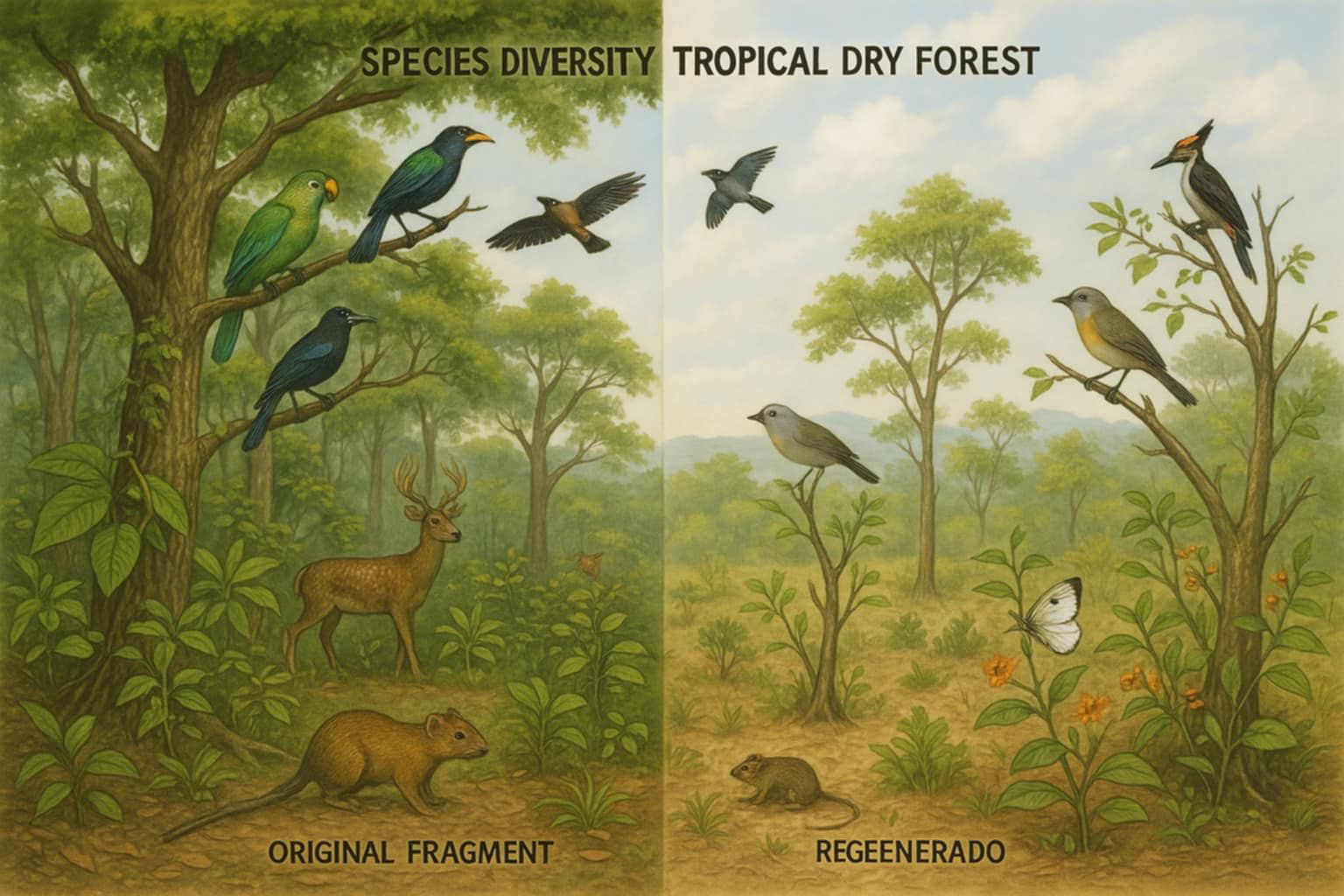Species diversity in tropical dry forests of Ecuador: How effective are regenerated ecosystems?
DOI:
https://doi.org/10.56124/sapientiae.v8i17.013Keywords:
Tropical dry forest, Sssisted regeneration, Biodiversity, Ecological succession, Ecological restorationAbstract
Tropical dry forests are ecosystems highly vulnerable to degradation, whose restoration requires effective conservation strategies. This study assessed the biodiversity of a tropical dry forest in its natural state and a forest under assisted regeneration, comparing species richness, equity, and community structure. Four sample plots of 20 x 50 meters each were established in ecosystems, and diversity indices were analyzed using iNEXT.4steps and PAST software. The results show that the natural forest has a higher species richness (54) than the regenerated forest (28) and a more even abundance distribution. The dominance of pioneer species in the regenerated forest indicates that it is still in an early stage of ecological succession. Extrapolation of diversity suggests that the restored ecosystem is unlikely to reach the complexity of natural forests in the medium term. These findings highlight the importance of complementary restoration strategies, such as introducing late-successional species, to accelerate structural and functional convergence. The study underscores the need for long-term monitoring to assess the effectiveness of assisted regeneration in tropical dry forests. More holistic restoration approaches could improve the resilience and stability of these ecosystems.
Downloads
References
Arroyo-Rodríguez, V., Melo, F. P. L., Martínez-Ramos, M., Bongers, F., Chazdon, R. L., Meave, J. A., Norden, N., Santos, B. A., Leal, I. R., & Tabarelli, M. (2017). Multiple successional pathways in human-modified tropical landscapes: new insights from forest succession, forest fragmentation and landscape ecology research. Biological Reviews, 92(1). https://doi.org/10.1111/brv.12231
Aryee, G. A., Sardinha, I. D., & Branquinho, C. (2024). Linking drivers of food insecurity and ecosystem services in Africa. In Frontiers in Sustainable Food Systems (Vol. 8). Frontiers Media SA. https://doi.org/10.3389/fsufs.2024.1272332
Blackie, R., Baldauf, C., Gautier, D., Gumbo, D., Kassa, H., Parthasarathy, N., Paumgarten, F., Sola, P., Pulla, S., Waeber, P., & Sunderland, T. (2014). Tropical dry forests. The state of global knowledge and recommendations for future research. CIFOR. https://doi.org/https://doi.org/10.17528/cifor/004408
Cantarello, E., Jacobsen, J. B., Lloret, F., & Lindner, M. (2024). Shaping and enhancing resilient forests for a resilient society. Ambio, 53(8), 1095–1108. https://doi.org/10.1007/s13280-024-02006-7
Chao, A. and Hu, K.-H. (2023). iNEXT.4steps Online: four-steps biodiversity analysis based on iNEXT. Code and user’s guide available from https://chao.shinyapps.io/iNEXT_4steps
Chao, A., & Jost, L. (2012). Coverage-based rarefaction and extrapolation: Standardizing samples by completeness rather than size. Ecology, 93(12). https://doi.org/10.1890/11-1952.1
Chao, A., & Jost, L. (2015). Estimating diversity and entropy profiles via discovery rates of new species. Methods in Ecology and Evolution, 6(8), 873–882. https://doi.org/10.1111/2041-210X.12349
Chao, A., & Ricotta, C. (2019). Quantifying evenness and linking it to diversity, beta diversity, and similarity. Ecology, 100(12). https://doi.org/10.1002/ecy.2852
Chao, A., Gotelli, N. J., Hsieh, T. C., Sander, E. L., Ma, K. H., Colwell, R. K., & Ellison, A. M. (2014). Rarefaction and extrapolation with Hill numbers: A framework for sampling and estimation in species diversity studies. Ecological Monographs, 84(1). https://doi.org/10.1890/13-0133.1
Chao, A., Kubota, Y., Zelený, D., Chiu, C. H., Li, C. F., Kusumoto, B., Yasuhara, M., Thorn, S., Wei, C. L., Costello, M. J., & Colwell, R. K. (2020). Quantifying sample completeness and comparing diversities among assemblages. Ecological Research, 1703.12102 35(2) 292-314. https://doi.org/10.1111/1440
Chazdon, R. (2015). Restoring Tropical Forests: A Practical Guide. Ecological Restoration, 33(1). https://doi.org/10.3368/er.33.1.118
Chazdon, R. L., Brancalion, P. H. S., Lamb, D., Laestadius, L., Calmon, M., & Kumar, C. (2017). A Policy-Driven Knowledge Agenda for Global Forest and Landscape Restoration.Conservation Letters,10(1). https://doi.org/10.1111/conl.12220
Elliott, S.D., D. Blakesley & K. Hardwick, 2013. Restoring Tropical Forests: a Practical Guide. Royal Botanic Gardens, Kew; 344 pp.
Gao, L., Zhao, G., Liang, L., & Chen, B. (2024). Achieving higher eco-efficiency for three staple food crops with ecosystem services based on regional heterogeneity in China. Science of The Total Environment, 948, 174942. https://doi.org/https://doi.org/10.1016/j.scitotenv.2024.174942
Gotelli, N., & Colwell, R. (2011). Estimating species richness. Biological Diversity. Frontiers in Measurement and Assessment, 2. https://doi.org/10.2307/3547060
Hammer, Ø., Harper, D. A. T., & Ryan, P. D. (2001). Past: Paleontological statistics software package for education and data analysis. Palaeontologia Electronica, 4(1).
Holl, K. D., & Aide, T. M. (2011). When and where to actively restore ecosystems? Forest Ecology and Management, 261(10). https://doi.org/10.1016/j.foreco.2010.07.004
Hong, T., & Chongjian, Y. (2024). Research on Ecosystem Service Supply, Demand and Ecological Resilience in the Context of Agriculture-Forestry-Animal Husbandry Composite System in Dibei Zagana, China. Polish Journal of Environmental Studies, 33(2). https://doi.org/10.15244/pjoes/174395
Hortal, J., Borges, P. A. V., & Gaspar, C. (2006). Evaluating the performance of species richness estimators: Sensitivity to sample grain size. In Journal of Animal Ecology, 75(1). https://doi.org/10.1111/j.1365-2656.2006.01048.x
Kumi, S., Nsiah, P. K., AHIABU, H. K., Ofosu-bamfo, B., Asigbaase, M., Anning, A. K., & Amponsah, G. (2024). Forest landscape restoration-induced changes in land cover and woody plant community structure in a degraded forest reserve in Ghana. Trees, Forests and People, https://doi.org/https://doi.org/10.1016/j.tfp.2024.100578 16, 100578.
Letcher, S. G., & Chazdon, R. L. (2009). Rapid recovery of biomass, species richness, and species composition in a forest chronosequence in Northeastern Costa Rica. 7429.2009.00517.x Biotropica, 41(5). https://doi.org/10.1111/j.1744-7429.2009.00517.x
Ma, Y., Wei, J., Wang, W., Huang, C., Feng, C., Xu, D., Haider, F. U., & Li, X. (2024). Monitoring Changes in Composition and Diversity of Forest Vegetation Layers after the Cessation of Management for Renaturalization. Forests, 15(6), 907. https://doi.org/10.3390/f15060907
Mahjoubi, I., Bossenbroek, L., Berger, E., & Frör, O. (2022). Analyzing Stakeholder Perceptions of Water Ecosystem Services to Enhance Resilience in the Middle Drâa Valley, Southern Morocco. Sustainability (Switzerland), 14(8). https://doi.org/10.3390/su14084765
Meli, P., Holl, K. D., Benayas, J. M. R., Jones, H. P., Jones, P. C., Montoya, D., & Mateos, D. M. (2017). A global review of past land use, climate, and active vs. passive restoration effects on forest recovery. In PLoS ONE (Vol. 12, Issue 2). https://doi.org/10.1371/journal.pone.0171368
Mesa-Sierra, N., de la Peña-Domene, M., Campo, J., & Giardina, C. P. (2024). Restoration of tropical dry forest: an analysis of constraints and successes across a highly threatened biome. In Frontiers in Environmental Science (Vol. 12). Frontiers Media SA. https://doi.org/10.3389/fenvs.2024.1458613
Miles, L., Newton, A. C., DeFries, R. S., Ravilious, C., May, I., Blyth, S., Kapos, V., & Gordon, J. E. (2006). A global overview of the conservation status of tropical dry forests. Journal of Biogeography, 33(3). https://doi.org/10.1111/j.1365-2699.2005.01424.x
Murphy, P. G., & Lugo, A. E. (1986). Ecology of tropical dry forest. Annual Review of Ecology and Systematics. 17. https://doi.org/10.1146/annurev.es.17.110186.000435
Oliveira, P. S., Falcão, L. A. D., Almeida, J. S., Fernandes, G. W., Reis Júnior, R., Nunes, Y. R. F., Veloso, M. das D. M., Beirão, M. do V., Neves, F. de S., Solar, R. R. C., Borges, M. A. Z., Silva, A. C., Salomão, R. P., Iannuzzi, L., Silva, L. F., Cabral, G. A. L., Sampaio, E. V. S. B., Macedo-Reis, L. E., Santos, C. F., … do Espírito Santo, M. M. (2024). Diversity patterns along ecological succession in tropical dry forests: a multi-taxonomic approach. Oikos, 2024(4), e09653. https://doi.org/https://doi.org/10.1111/oik.09653
Oluwajuwon, T. V., Chazdon, R. L., Ota, L., Gregorio, N., & Herbohn, J. (2024). Bibliometric and literature synthesis on assisted natural regeneration: an evidence base for forest and landscape restoration in the tropics. Frontiers in Forests and Global Change, 7, 1412075. https://doi.org/10.3389/ffgc.2024.1412075
Pielou EC. 1966. The measurement of diversity in different types of biological collections. Journal of Theoretical Biology 13(C). https://doi.org/10.1016/0022-5193(66)90013-0
Poorter, L., Bongers, F., Aide, T. M., Almeyda Zambrano, A. M., Balvanera, P., Becknell, J. M., Boukili, V., Brancalion, P. H. S., Broadbent, E. N., Chazdon, R. L., Craven, D., de Almeida-Cortez, J. S., Cabral, G. A. L., de Jong, B. H. J., Denslow, J. S., Dent, D. H., DeWalt, S. J., Dupuy, J. M., Durán, S. M., … Rozendaal, D. M. A. (2016). Biomass resilience of Neotropical secondary forests. Nature, 530(7589). https://doi.org/10.1038/nature16512
Rath, S., Kiran Kumara, T. M., Das, A., & Sarangi, K. K. (2024). Economic Valuation of Ecosystem Services in Indian Agricultural Landscape: A Meta-analysis. Economic Affairs (New Delhi), 69(2), 939–950. https://doi.org/10.46852/0424-2513.3.2024.19
Reid, J. L., Holl, K. D., & Zahawi, R. A. (2015). Seed dispersal limitations shift over time in tropical forest restoration. Ecological Applications, 25(4). https://doi.org/10.1890/14-1399.1
Shannon CE. 1948. A Mathematical Theory of Communication. Bell System Technical Journal 7305.1948.tb01338.x 27(3). https://doi.org/10.1002/j.1538-7305.1948.tb01338.x
Simpson EH. 1949. Measurement of diversity. Nature 163(4148). https://doi.org/10.1038/163688a0

Published
Versions
- 2025-07-10 (5)
- 2025-07-10 (4)
How to Cite
Issue
Section
License
Copyright (c) 2025 Revista Científica Multidisciplinaria SAPIENTIAE. ISSN: 2600-6030.

This work is licensed under a Creative Commons Attribution-NonCommercial-ShareAlike 4.0 International License.

2.jpg)


















